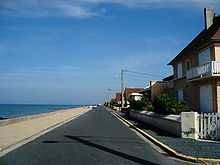Ver-sur-Mer
| Ver-sur-Mer | |
|---|---|
 | |
 Ver-sur-Mer | |
|
Location within Lower Normandy region  Ver-sur-Mer | |
| Coordinates: 49°19′55″N 0°31′42″W / 49.3319°N 0.5283°WCoordinates: 49°19′55″N 0°31′42″W / 49.3319°N 0.5283°W | |
| Country | France |
| Region | Lower Normandy |
| Department | Calvados |
| Arrondissement | Bayeux |
| Canton | Ryes |
| Intercommunality | Bessin, Seulles et Mer |
| Government | |
| • Mayor (2008–2014) | Philippe Onillon |
| Area | |
| • Land1 | 9.01 km2 (3.48 sq mi) |
| Population (2008) | |
| • Population2 | 1,565 |
| • Population2 Density | 170/km2 (450/sq mi) |
| INSEE/Postal code | 14739 / 14114 |
| Elevation |
0–56 m (0–184 ft) (avg. 42 m or 138 ft) |
|
1 French Land Register data, which excludes lakes, ponds, glaciers > 1 km² (0.386 sq mi or 247 acres) and river estuaries. 2 Population without double counting: residents of multiple communes (e.g., students and military personnel) only counted once. | |
Ver-sur-Mer is a commune in the Calvados department in the Basse-Normandie region in northwestern France.
It is located at the eastern end of Gold Beach between Arromanches and Courseulles. The town is 25 km from Caen and 16 km from Bayeux.
This village has a pony club, a small supermarket, a sailing club, tennis court, French bakery, beach, shrimp fishing, a youth hostel and more. It is also home to the America-Gold Beach Museum.
Ver-sur-Mer's lighthouse was built in 1908 on the heights above the beach. It is still active today with its distinctive three white flashes. During World War II, Canadian troops seized the lighthouse swiftly, however, it was badly damaged and had to be restored after the end of the war.
Saint-Martin is Ver-sur-Mer's church which was constructed between the 10th-12th century.
History
On 1 July 1927, Commander Richard Evelyn Byrd was forced to crash land his plane, America, in the sea off Ver-sur-Mer after his attempt at the first mail-carrying flight across the Atlantic failed.
On 6 June 1944, D-Day, the British 50th Infantry division landed at Ver-sur-Mer as part of the Normandy Landings invasion, Operation Overlord.

Population
| Historical population | ||
|---|---|---|
| Year | Pop. | ±% |
| 1962 | 623 | — |
| 1968 | 580 | −6.9% |
| 1975 | 701 | +20.9% |
| 1982 | 966 | +37.8% |
| 1990 | 1,359 | +40.7% |
| 1999 | 1,307 | −3.8% |
| 2008 | 1,565 | +19.7% |
See also
References
| Wikimedia Commons has media related to Ver-sur-Mer. |